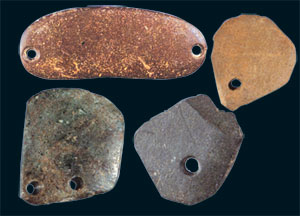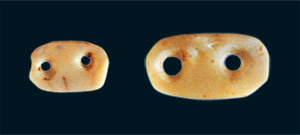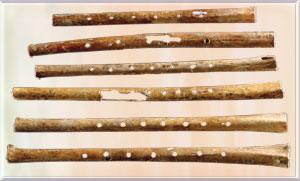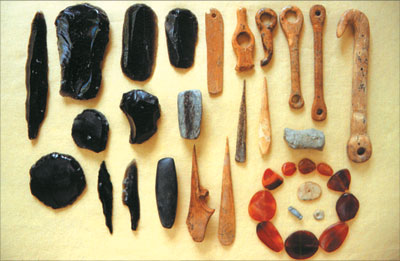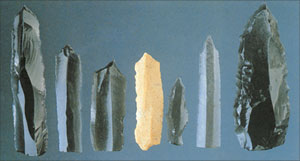Introduction
 |
| This tool, made out of obsidian—a dark, glass-like rock—dates back to 10,000 BCE. It is impossible to shape obsidian just by hitting it with a stone. |
The evolutionist historical perspective studies the history of mankind by dividing it up into several periods, just as it does with the supposed course of human evolution itself. Such fictitious concepts as the Stone Age, Bronze Age and Iron Age are an important part of the evolutionist chronology. Since this imaginary picture is presented in schools and in television and newspaper stories, most people accept this imaginary picture without question and imagine that human beings once lived in an era when only primitive stone tools were used and technology was unknown.
 |
| Spoons show that the people of the time had table manners. This is further evidence that they did not lead primitive lives, as evolutionists claim. |
Yet when archaeological findings and scientific facts are examined, a very different picture emerges. The traces and remains that have come down to the present—the tools, needles, flute fragments, personal adornments and decorations—show that in cultural and social terms, humans have always lived civilized lives in all periods of history.
Hundreds of thousands of years ago, people lived in houses, engaged in agriculture, exchanged goods, produced textiles, ate, visited relatives, took an interest in music, made paintings, treated the sick, performed their acts of worship and, in short, lived normal lives just as they do today.
| One of the proofs that primitive-minded ape-men never existed is this 40,000-year-old flute. Scientific research shows that flutes like this one, based on the present-day seven-note Western scale, were used tens of thousands of years ago. |  |
People who heeded the prophets sent by God came to have faith in Him, the One and Only, while others worshipped idols. Believers with faith in God abided by the moral values commanded by Him, while others engaged in superstitious practices and deviant rites. At all times in history, just as today, there have been people who believed in the existence of God, as well as pagans and atheists.
Of course, throughout history, there have always been those living under simpler, more primitive conditions as well as societies living civilized lives. But this by no means constitutes evidence for the so-called evolution of history, because while one part of the world is launching shuttles into space, people in other lands are still unacquainted with electricity. Yet this does not mean that those who build spacecraft are mentally or physically more advanced—and have progressed further down the supposed evolutionary road and become more culturally evolved—nor that the others are closer to the fictional ape-men. These merely indicate differences in cultures and civilizations.
Evolutionists Cannot Account for Archaeological Discoveries
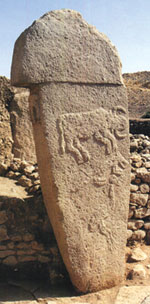 |
| This stone carving is 11,000 years old—when, according to evolutionists, only crude, stone tools were in use. However, such a work cannot be produced by rubbing one stone against another. Evolutionists can offer no rational, logical explanation of such reliefs formed so accurately. Intelligent humans using tools of iron or steel must have produced this and other similar works. |
When you examine an evolutionist's history of mankind, you'll notice the detailed depictions of how man's allegedly primitive ancestors went about their daily lives. Anyone impressed by the confident, authoritative style, but without much knowledge of the subject, may well assume that all these "artistic reconstructions" are based on scientific evidence.
Evolutionist scientists arrive at detailed descriptions as if they had been around thousands of years ago and had the opportunity to carry out observations. They say that when our supposed ancestors—who had now learned to stand on two legs and had nothing else to do with their hands—began making stone tools, and for a very long period used no other implements other than ones made of stone and wood. Only at a much later date did they start to use iron, copper and brass. Yet these accounts are based on misinterpretation of findings in the light of evolutionist preconceptions, rather than on scientific proof.
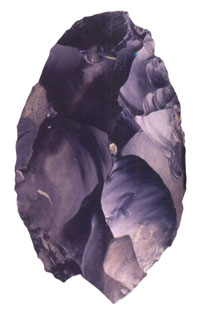 |
| For this 550,000-year-old stone hand-axe to have been cut and shaped so accurately other tools made out of even harder metals such as iron or steel must have been employed. |
In his book Archaeology: A Very Short Introduction, archaeologist Paul Bahn says that the scenario of mankind's evolution is nothing but a fairy tale, adding that so much of science is based on such tales. He stresses that he uses the word "tale" in a positive sense, but that still, this is exactly what they are. He then invites his readers to consider the traditional attributes of the so-called human evolution: cooking and campfires, dark caves, rites, tool-making, aging, struggle and death. How much of these conjectures, he wonders, are based on bones and actual remains, and how much on literary criteria?
Bahn is reluctant to openly answer the question he poses: namely, that man's alleged evolution is based on "literary" criteria rather than scientific ones.
In fact, there are a great many unanswered questions and logical inconsistencies in these accounts, which someone thinking along the lines of evolutionist dogma will fail to detect. Evolutionists refer to a Stone Age, for example, but are at a loss to explain how implements or remains from the time could have been carved and shaped. In the same way, they can never explain how winged insects first came to fly, though they maintain that dinosaurs grew wings and thus started to fly by trying to catch them. They prefer to forget the whole question, and to have others do the same.
Yet shaping and carving stone is no easy task. It is impossible to produce perfectly regular and razor-sharp tools, as in the remains that have come down to us, by scraping one stone against another. It is possible to shape hard stones such as granite, basalt or dolerite without them crumbling apart only by using steel files, lathes and planes. It is equally obvious that bracelets, earrings and necklaces dating back tens of thousands of years could not have been crafted using stone tools. The tiny holes in such objects cannot be made with stones. The decoration on them cannot be produced by scraping. The perfection in the objects in question shows that other tools made of hard metals must have been employed.
There Never Was a Stone Age | |||||||
In the period denigrated by evolutionists as the "Stone Age," people worshipped, listened to the message preached by the messengers sent to them, constructed buildings, cooked food in their kitchens, chatted with their families, visited their neighbors, had tailors sew clothes for them, were treated by doctors, took an interest in music, painted, made statues—and, in short, lived perfectly normal lives. As archaeological findings show, there have been changes in technology and accumulated knowledge over the course of history. But humans have always lived as human beings.
This Late Neolithic necklace of stones and shells reveals not only the artistry and tastes of the people of the time, but also that they possessed the necessary technology to produce such decorative objects. Pots, a model table, and a spoon dating to between 7,000 and 11,000 BCE provide important information about the living standards of people of the time. According to evolutionists, people of that age had only recently adopted a settled lifestyle and were only just becoming civilized. Yet these materials show that there was nothing lacking from these people's culture, and that they lived a fully civilized existence.
Just as we do today, they sat at tables, ate using plates, knives, spoons and forks, played host to their guests, offered them refreshments—and in short, lived regular lives. When the findings are examined as a whole, we see that with their artistic understanding, medical knowledge, technical means and daily lives, Neolithic people lived fully human lives just like those before and after them. 12,000-year-old beadsRight: According to archaeologists, these stones, dating back to around 10,000 BCE, were used as beads. The perfectly regular holes in such hard stones are particularly noteworthy, since tools made out of steel or iron must have been used to drill them.
A 12,000-year-old buttonLeft: These bone buttons, used around 10,000 BCE, show that the people of the time had clothing with fasteners. A society that uses buttons must also be familiar with sewing, cloth making, and weaving.
9,000 to 10,000-year-old needles and awlRight: These needles and awl, which date back to around 7,000 to 8,000 BCE, offer important evidence of the cultural lives of the people of the time. People who use awls and needles clearly led fully human lives, and not an animalistic existence, as evolutionists maintain.
A 12,000-year-old copper awlLeft: This copper awl, dating back to around 10,000 BCE, is evidence that metals were known about and mined, and shaped during the period in question.
Copper ore, typically found in crystal or powder form, appears in the form of seams in old, hard rocks. Any society that made a copper awl must have recognized copper ore, managed to extract it from inside the rock and have had the technological means with which to work it. This shows that they had not just recently been primitive, as evolutionists maintain. The flutes in the picture are an average of 95,000 years old. People who lived tens of thousands of years ago possessed a taste for musical culture. |
The "Polished Stone" Deception | |||
The most striking stonework has survived down to the present day in archaeological remains. In order to be able to give stone such a detailed and regular shape, powerful steel tools generally need to be employed. One cannot make fine shapes and designs by abrading or rubbing one stone together with another. Technical infrastructure is essential to accurately cut stones as hard as granite and make patterns on their surface. Many stone implements remain sharp and bright, reflecting from accurate cutting and shaping. The way evolutionist scientists describe the era they came from as the "Polished Stone Age" is completely unscientific. It is impossible for polish to be preserved over thousands of years. The stones in question shine because they were accurately cut, not because, as is claimed, they were polished. This brightness stems from inside the stone itself.
Of the bracelets in the above picture, the one on the left is made of marble, and the right one from basalt. They date back to between 8,500 and 9,000 BCE. Evolutionists claim that in that period, only tools made out of stone were used. But basalt and marble are exceptionally hard substances. In order for them to be turned into such rounded links, steel blades and equipment must be used. It is impossible for them to have been cut and shaped without the use of steel tools. If you give anyone a piece of stone and ask him to use it to turn a piece of basalt into a bracelet like that in the picture, what degree of success will they have? Rubbing one stone against another or striking them against one another cannot, of course, produce a bracelet. Moreover, these artifacts show that the people who made them were civilized individuals with aesthetic tastes and an understanding of beauty.
The illustrations show hand-made tools of obsidian and bone, hooks and various objects made out of stone. Obviously, one cannot obtain such regular shapes by striking raw material with a stone. Crude blows will merely break the bone and prevent the desired shape from taking form. In the same way, it is clear that sharp lines and pointed tips cannot be possible, even with tools of the very hardest stone, such as granite and basalt. These stones are cut regularly, just like slicing fruit. Their brightness stems not from their being polished, as evolutionists maintain, but from the shaping itself. Those who made these items must have had devices of iron or steel to let them shape these materials in the manner they wished. Slabs of hard stone can be cut so accurately only by using a material even harder, such as steel. |
You can't Carve Stone with Stone | |
1. Stone inlays dating back to around 10,000 BCE These stone tools date back on average to between 10,000 and 11,000 BCE. Imagine that you wanted to make any one of the objects here by hitting or rubbing one stone with another, in the way evolutionists maintain was done at the time. Try to make regular holes such as those in figure 4. No matter how many times you strike the piece of rock in your hand, you will never be able to make such a perfect hole. To do so, you will need to use a drill made of some harder substance like steel. |
Many archaeologists and scientists have performed tests to see whether such ancient artifacts could have been manufactured under the conditions that evolutionists conjecture. For example, Professor Klaus Schmidt carried out one such experiment on the carvings on the stone blocks at Göbekli Tepe in Turkey, estimated to date back some 11,000 years. He gave workmen stone tools, of the kind evolutionists claim were employed at the time, and asked them to produce similar carvings on similar rocks. After two hours of non-stop work, all that the workmen managed to complete was a vague line.
You can carry out a similar experiment at home. Take a piece of hard stone such as granite and try to turn it into a spearhead of the kind used by people living 100,000 years ago. But you are not allowed to use anything else than that piece of granite and a stone. How successful do you think you might be? Can you produce a piece with the same narrow point, symmetry, smoothness and polish as those found in the historical strata? Let us go even further; take a piece of granite one meter square and on it, try and carve a picture of an animal, imparting a sense of depth. What kind of result could you produce by grinding that rock with another piece of hard stone? Clearly, in the absence of tools made of steel and iron you can make neither a simple spearhead, much less an impressive stone carving.
Stone-cutting and stone carving are fields of expertise all their own. The requisite technology is essential in order to make files, lathes and other tools. This demonstrates that at the time these objects were made, the "primitive" technology was well advanced. In other words, evolutionists' claims that only simple stone implements were known, that there was no technology in existence, are myths. Such "Stone-Only" Age has never existed.
However, it is perfectly plausible that any steel and iron tools used in cutting and shaping stones should not have survived down to the present day. In a naturally moist and acidic environment, all kinds of metal tools will oxidize and eventually disappear. All that will be left is chips and fragments of the stone they worked, which take much longer to vanish. But to examine these fragments and suggest that people at the time used only stone is not scientific reasoning.
Indeed, a great many evolutionists now admit that archaeological findings do not support Darwinism at all. Richard Leakey, an evolutionist archaeologist, confessed that it's impossible to account for the archaeological findings, especially stone tools, in terms of the theory of evolution:
In fact, concrete evidence of the inadequacy of the Darwinian hypothesis is to be found in the archeological record. If the Darwinian package were correct, then we would expect to see the simultaneous appearance in the archeological and fossil records of evidence for bipedality, technology, and increased brain size. We don't. Just one aspect of the prehistoric record is sufficient to show that the hypothesis is wrong: the record of stone tools. 1
The Fictitious Evolutionist Chronology
 |
| These pieces of copper, dating back to between 8,000 and 10,000 BCE, are believed to have been used as beads. The people of the time possessed the technical know-how to find copper ore and then work it. |
In classifying history, evolutionists interpret the objects they find in line with their own dogmatic theories. The period during which bronze artifacts were manufactured they call the Bronze Age, and suggest that iron began being used much more recently—based on their claim that in the most ancient civilizations, metals were unknown.
As already mentioned, however, iron, steel and many other metals quickly oxidize and decay, much faster than stone does. Some metals such as bronze, which oxidize with much greater difficulty, may survive for longer than others. It is therefore perfectly natural that excavated objects made of bronze should be older and those of iron of a much more recent date.
In addition, it's not logical to maintain that any society able to produce bronze was unaware of iron, that a society with the technical knowledge to produce bronze did not use any other metals.
Bronze is obtained by adding tin, arsenic and antimony, with a small quantity of zinc, to copper. Anyone who creates bronze must have a working knowledge of such chemical elements as copper, tin, arsenic, zinc and antimony, know at what temperatures these are to be melted, and possess a kiln in which to melt and combine them. Without all this knowledge, it will be very difficult to produce a successful alloy.
To begin with, copper ore is found in old, hard rocks in powder or crystalline form (which is also referred to as "native copper"). A society that uses copper must first possess a level of knowledge to identify it in powder form in these rocks. It must then construct a mine to extract the copper, remove it, and carry it to the surface. It is clear that these things cannot be done using stone and wooden tools.
Copper ore must be introduced to red-hot flame in order for it to liquefy. The temperature needed to melt and refine copper is 1 084.5 oC (1 984 oF). There also needs to be a device or bellows to ensure a steady flow of air to the fire. Any society working with copper must construct a kiln able to produce such high heat and also make such equipment as crucibles and tongs for use with the furnace.
This is a brief summary of the technical infrastructure needed to work copper—which by itself, is too soft a metal to hold a sharp edge for long. Producing harder bronze by adding tin, zinc and other elements to copper is even more sophisticated, because every metal requires different processes. All these facts show that communities engaged in mining, producing alloys and metal-working must have possessed detailed knowledge. It is neither logical nor consistent to claim that people with such comprehensive knowledge would never have discovered iron.
On the contrary, archaeological discoveries show that the evolutionist claim that metal was unknown and not used in very ancient societies is untrue. Proof includes such findings as the remains of a 100,000-year-old metallic vessel, 2.8-billion-year-old metal spheres, an iron pot estimated to be 300 million years old, fragments of textiles on clay dated to 27,000 years ago, and traces of metals such as magnesium and platinum, successfully melted in Europe only a few hundred years ago, in remains dating back a thousand years. These scattered remains totally demolish the Rough Stone Age, Polished Stone Age, Bronze and Iron Age classifications. But a large part of these findings, after appearing in many scientific publications, have either been ignored by evolutionist scientists or else hidden away in museum basements. Fantastical evolutionist tales have been presented as the history of mankind, instead of the true facts.
Believers Have Led Civilized Lives Throughout History
 |
| The true religion, together with superstitious beliefs, have existed in all periods of history, just as they do today. At all times, believers have fulfilled their religious observances in obedience to God's command. |
Throughout the course of history, God has sent messengers to call people to the true path. Some people have obeyed these messengers and believed in the existence and oneness of God, while others have persisted in denial. Ever since humans first came into existence they have learned faith in the one and only God, and the moral values of the true religion, by means of our Lord's revelations. Therefore, the evolutionist claim that earliest societies did not believe in the One and Only God is untrue. (Greater detail will be provided on this subject later in this book.)
The Qur'an reveals how, in all periods of history, God has sent messengers to call people to believe and live by religious moral values:
Humanity was a single community. Then God sent out prophets bringing good news and giving warning, and with them He sent down the Book with truth to decide between people regarding their differences. Only those who were given it differed about it, after the clear signs had come to them, envying one another. Then, by His permission, God guided those who believed to the truth of that about which they had differed. God guides whoever He wills to a straight path. (Qur'an, 2:213)
Another verse reveals that a messenger has been sent to every society to warn its members, remind them of the existence and oneness of God, and to call them to abide by religious virtues:
. . . There is no community to which a warner has not come. (Qur'an, 35:24)
Although our Lord has sent people messengers and sacred scriptures, some have fallen into misunderstanding, turned their backs on the virtues of the true religion and adopted deviant superstitious beliefs. Some have developed pagan beliefs and fallen into the perversion of worshipping the earth, stone, wood, the Moon or the Sun, and even so-called evil spirits. Even today, along with believers in the true religion, there are also some who worship fire, the Moon, the Sun or idols made of wood. Some people ascribed partners to our Lord, even though they were fully aware of His existence and uniqueness. Yet still our Lord has sent them messengers, revealed to them the errors they had fallen into, and called on them to abandon their superstitious beliefs and live according to the true religion. And in all periods in history, there have been believers and unbelievers, those with a pure faith and those who have gone down paths of perversion.
Throughout history, believers who have lived with the prophets have enjoyed high-quality lives under very civilized conditions. They lived within a sophisticated social order in the days of the Prophets Noah, Abraham, Joseph, Moses and Solomon (peace be upon them all), just as they do today. In all ages, believers have prayed, fasted, heeded the bounds set by God, and lived clean and lawful lives. Archaeological findings reveal the best, noblest and cleanest standards of living from those possessed by devout believers in God. The prophets and true believers used the finest means available in their times, in a manner appropriate to His approval.
 |
| Today there are people with superstitious beliefs who worship idols, just as there were in past ages. |
All technological progress in the time of Nimrud was used in the best way by Prophet Abraham (pbuh) and those who believed with him. Technical knowledge in the time of Pharaoh was used in the service of Prophets Joseph, Moses, Aaron (peace be upon them all) and true believers of that time. The high level of technology attained in the fields of architecture, art and communications in the time of Prophet Solomon (pbuh) was employed in the wisest manner. The wealth and magnificence that our Lord bestowed as a blessing on Prophet Solomon (pbuh) inspired awe down the generations.
We must remember that the information and means possessed by those living hundreds of thousands of years ago, and by people alive today, are blessings from God. People who founded civilizations hundreds of thousands of years ago, who created beautiful paintings on cave walls tens of thousands of years ago, who built the pyramids and ziggurats, who constructed giant stone monuments and who constructed great structures on the highest altitudes in Peru did so through God's inspiration and teaching. People who study the sub-atomic particles today, who send shuttles into space and who write computer software do so because God so wills. All the information that human beings have possessed since they were first created is a blessing from God, and every civilization they have founded is equally the work of our Lord.
God created man out of nothing and gives him various tests and blessings throughout his life in this world. Every blessing bestowed is also a test. People who know that the civilization, technology and means they possess are actually all blessings from God give thanks to our Lord, Who increases His blessings on them:
And when your Lord announced: "If you are grateful, I will certainly give you increase . . ." (Qur'an, 14:7)
God causes His devout servants to enjoy pleasant lives both in this world and in the Hereafter. This is revealed in the Qur'an:
Anyone who acts rightly, male or female, being a believer, We will give them a good life and We will recompense them according to the best of what they did. (Qur'an, 16:97)
As a manifestation of this verse, all Muslims throughout history have possessed the finest means of the age they lived in, and have led pleasant lives. Naturally, some have been tested with difficulty and troubles, but this does not suggest that they lived under difficult, primitive conditions and did not live civilized, humane lives. No matter how wealthy, comfortable and advanced their civilizations might have been, those who have denied God and persisted in their denial, who failed to live by proper moral values and brought about corruption on Earth, have always ended up disappointed. In addition, many of them have perhaps enjoyed more advanced technologies than those of present-day societies. This is also revealed in the Qur'an:
Haven't they traveled in the Earth and seen the final fate of those before them? They had greater strength than them and cultivated the land and inhabited it in far greater numbers than they do. Their messengers also came to them with the clear signs. God would never have wronged them; but they wronged themselves. (Qur'an, 30:9)
Pieces Millions Of Years Old That Evolutionists Cannot Account For | ||||||||
According to the theory of evolution, living things evolved through specific stages, from a bacterium down to human beings, taking place in an imaginary sequence lasting millions of years. In this scenario, Man is the last evolved living thing and has completed his development within the last 20,000 years. Yet scientific findings and the fossil record provide not a single piece of evidence that such developments ever took place. In fact, they show that such is not possible.
Other findings include tools and decorative objects, once used by human beings, dating back millions of years. Darwinists are quite unable to place in their imaginary evolutionary tree any human beings who lived 50 or even 500 million years ago—a time when they maintain that there were no living things on Earth apart from trilobites. It's of course impossible for them to do so! God brought human beings into existence with the simple command "Be!" in the same way that He did all other living things.
Therefore, we are just as likely to make discoveries regarding the remains of people who lived 500 million years ago as those of who lived 100 years ago. God, Who created all things out of nothing, can certainly bring into existence any living thing He wills, at whatever period in history He wills. This is of course an easy matter for God, with His infinite might and power. But Darwinists fail to comprehend this truth, which is why they have no explanation to offer for all the proofs of Creation. They have no other solution than to repeat scenarios that have already been undermined by scientific facts. But with every passing day, evidence from excavations being carried out further demolishes the dogma of evolution. |
Cultural Accumulation is No Evidence of Any Evolutionary Process
 |
| Solomon and the Queen of Sheba, by Frans Francken II the Younger, Musee des Beaux-Arts, Quimper, France |
Evolutionists maintain that the first human beings were half-ape creatures whose mental and physical characteristics developed over the course of time, that they acquired new abilities, and that civilizations evolved for that reason. According to this claim, based on no scientific evidence whatsoever, our supposed primitive ancestors led animalistic lives, became civilized only after they became human, and registered cultural progress as their mental capacities developed. Fictitious images of primitive Man, with a body entirely covered in fur, or seeking to make fire while squatting under animal skins, walking along the waterside with a freshly killed animal on his shoulder, or seeking to communicate with his peers by gestures and grunting, are false recreations based on this unscientific claim.
The fossil record does not support this fantasy. All scientific findings point to the conclusion that Man was created as Man, out of nothing, and has always lived as human since the first day he was brought into being. Neither do archaeological findings support the evolutionist chronology in any way. Findings from the period when evolutionists claim that humans had only learned to speak show that human beings of the time had kitchens and enjoyed family lives. Decorative objects and raw materials for paint have been found in excavations from times when evolutionists say that humans were still unaware of art. Many examples will be considered in detail in later chapters of this book.
 |
| Madonna with Saints, by Giovanni Bellini, Venice, 1505 |
All these discoveries reveal that humans never endured primitive, animalistic lives. There never was an uncivilized age when all people used only stone and wooden implements. Believers have always led human lifestyles, with clothes, plates, bowls, spoons and forks used in a manner befitting human beings. People have always lived in circumstances, spoken, constructed buildings and produced artworks befitting human beings. There have been doctors, teachers, tailors, engineers, architects and artists, in established social orders. By the inspiration of God, people possessed of reason and good conscience have always made the finest use of the blessings on Earth.
Of course, as technology has advanced and peoples have accumulated knowledge, there have naturally been technological changes. New devices have been developed in line with the prevailing circumstances, scientific discoveries have been made, and cultural changes have occurred. However, the accumulation of knowledge and technological progress made over the course of history do not imply that any evolution took place.
It's perfectly natural for knowledge to keep on accumulating. A person enjoys different levels of learning in primary school, in his high school years and at university. But if someone constantly accumulates knowledge throughout his life, that doesn't mean that he is constantly evolving and progressing by means of random effects. A similar dynamic applies to the life of a society. New discoveries are also made in light of a society's needs, new mechanisms are invented and subsequently improved upon by later generations. Yet this is not a process of evolution.
Footnote
1. Richard Leakey, The Origin of Humankind (Science Masters Series), New York: BasicBooks, 1994, S. 12.



